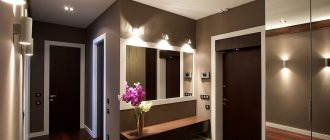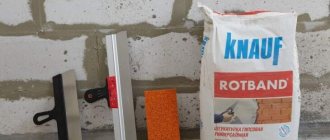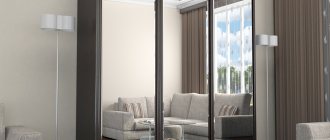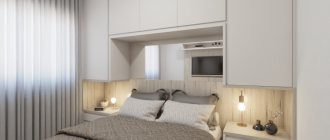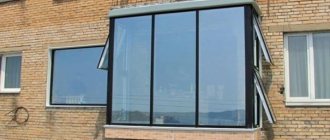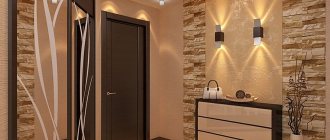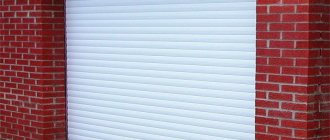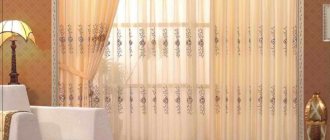Every homeowner wants to see their home beautiful, well-groomed and unique. The good thing is that the use of modern building materials makes it possible to realize most of his fantasies. The entrance hall can be called the face of any home, be it a country residence or a city apartment. Guests form their opinion about the house often under the impression of the hallway and its appearance. And that’s why interior designers pay special attention to it.
Decorative plaster in the interior in the hallway.
For its finishing, many materials are used, and not the least important role among them is played by decorative plaster in the hallway. What it is, how to prepare it and put it into practice, we’ll talk about all this below.
What should the plaster be like?
An example of decorative plaster in the interior.
Plaster composition is essentially a mixture based on a number of components (cement, clay, sand), which is used for the final finishing of walls and ceilings. But, it should be understood that such plaster is fundamentally different from general construction plaster, used for rough processing of walls and ceilings.
Decorative plaster in light colors.
Decorative natural plasters are multilayer coatings that include at least two layers. The first layer is a primer, it must be compatible with the wall material. That is, one primer is used for brick, another for wood, etc. For final finishing, a mixture is used, which consists of a binder component that is saturated with various types of fillers.
Bark beetle
This type of decorative plaster can rarely be found in the hallway. But it is possible: here is a vivid example of this. The bark beetle is mainly used for finishing facades, but there are also exclusively home options.
For example, this one. A pleasant atmosphere is immediately established in the hallway, conducive to a serene rest.
Solid appearance and increased practicality - a homeowner using a bark beetle is chasing two birds with one stone and successfully catching up with them.
This photo demonstrates the somewhat ascetic design of the hallway. However, the decorative plaster in the photo adds notes of orderliness and universal balance.
Note to all those who have planned renovations in the hallway: bark beetle is recommended to be used in rooms with a large supply of square meters.
Types of plaster
Venetian plaster in the design of the corridor.
When carrying out finishing works, the following types of decorative plaster are used:
- Ordinary monolithic plaster;
- Terrasite;
- Venetian;
- Bark beetle;
- Modeling and many others.
Textured plaster in room design.
Terrasite plaster is intended mainly for exterior finishing. But in the modern building materials market, where plaster of this type is presented, there is also one adapted for indoor use. It consists of Portland cement, limestone flour and quartz; there are other compositions, for example, which include mica crumbs.
Types of terrazite plaster for finishing.
Venetian plaster includes stone flour. Usually marble is used to obtain it. In addition to it, granite, malachite, etc. are used. It is added to the finished plaster mixture and then applied to the prepared wall.
Wall decoration with Venetian plaster.
Corridor plaster of the bark beetle type is available in two versions - acrylic and gypsum. The first plaster is a ready-to-use mixture. The gypsum composition is a mixture that will need to be prepared for use. It includes marble granules or mineral chips. Their size determines the grain size of the material and its appearance.
Structural paint and flocking
Example of structural paint for wall covering.
One of the new building materials is structural paint, sometimes called textured paint. Recently, it has become widely used for finishing work. This paint allows you to create any pattern, and thus can be used instead of wallpaper. But this material has a significant drawback - high cost. On the other hand, its service life can be counted in decades, and this will more than pay for its costs. What distinguishes it from ordinary paint is not its composition, but the method of application to the wall surface.
Flock is a filler that is added to paints to create a more impressive look. To obtain it, wool, cotton, etc. are used; it is also made from polymers.
The best plasters: photos in the interior
Let's consider the types of decorative plasters that are often chosen for walls in the hallway and corridor. Detailed articles have been written on our website about how to do this type of finishing yourself. You can get acquainted with them by following the link in the name of the plaster.
American.
This simple type of texture is obtained by spraying the finishing mixture onto the walls through a cartouche gun. The droplets scatter randomly, their shape depends on the pressure on the compressor and the size of the nozzles on the sprayer. This type of plastering is often used in new buildings; “American” is used to cover walls in common corridors and stairwells.
Large texture
"American" in several colors
This is what the “American” looks like after grouting
With smoothed relief
The advantages include ease of implementation, low cost, and maintainability. As a rule, ordinary gypsum mixtures are used for application, which must be additionally painted.
Venetian.
This is perhaps the most labor-intensive and most effective type of decorative plaster for interior walls. Venetian plaster imitates natural polished stone: marble, granite, malachite, onyx, etc. For the hallway, neutral light colors are used, which, together with the gloss on the surface of the plaster, visually expand the small space.
Marble
Gray granite
In light colors
Yellow-green with veins
“Venetian” must be covered with decorative wax. It adds shine to the finish, protects against dust and moisture, and strengthens the plaster. I note that the surface for this type of decor must be perfectly leveled, just like for painting.
Grotto (World Map).
Textured wall decoration, similar to a world map with “islands,” is often used to decorate walls in the hallway, living room and bedroom. This plaster has earned its popularity due to its ease of application. All you need to do the job is a trowel and a spatula. In addition, there is no need to putty the walls before repairs; the “world map” relief will hide minor defects.
Bark beetle.
The texture of the “bark beetle” resembles the passages of a beetle in wood. Such marks are caused by small granules in the plaster. When the mixture is leveled on the wall and smoothed over with a trowel, the granules roll and create grooves.
By itself, this decorative plaster is boring and is mainly used for facade work. But if you paint it in two colors, highlighting the tops and valleys of the relief, it can turn out very cool. Plastering is not difficult; you can do it yourself. In general, I recommend taking note.
Bark beetle texture
On the stairs
In the hall
vertical drawing
Mosaic.
This is one of my favorite plasters. The principle of “quickly do it and forget it” is rightfully applicable to it. The decorative mixture consists of natural stone granules; they can be the same color or different, like a mosaic. The pebbles are mixed on a polymer base. Simply spread the plaster evenly over the wall in a thin layer.
Pros: high wear resistance, not afraid of moisture, easy to repair if damaged. For a corridor or hallway this is a very practical option.
Under concrete.
If you like the loft style and minimalism in the interior, then pay attention to decorative plaster that imitates concrete. Its smooth gray surface with small "natural" scratches and rips is great for areas where you don't spend a lot of time. Cool gray shades are now in trend; use them in the corridor together with modern lighting systems such as track lamps and spots.
Travertine.
Another version of decorative plaster, which has become a classic. The texture of natural stone with a slight shine and roughness is suitable for any room in the house, be it a kitchen or hallway. Walls covered with travertine look great together with wood laminate flooring.
If you use lime-cement mixtures with marble filler for finishing, then you can forget about scratches on walls and doorways. Which is very important for entering the apartment and corridor.
Of course, this list does not limit the variety of decorative textured plasters. The good thing about them is that each master can make something unique by changing the combination of colors or application technique.
Combination of finishing materials
Combination of decorative plaster and wallpaper in the hallway.
Textured plaster is often laid at the bottom of the wall. It is most susceptible to contamination; the upper part can be covered with wallpaper. The columns are finished in the same way.
Textured plaster is a beautiful material, and if you divide a wall using a baguette or plinth and apply mortar, it will be possible to get the illusion that the walls are covered with marble or other finishing stone, for example, malachite.
The combination of several types of coatings in one space allows you to decorate the wall as a full-fledged panel. By the way, this move is used by designers when decorating and decorating spacious hallways or halls.
Decorative plaster – which is better?
When finishing the walls in the corridor, it is recommended to use plaster, which has not only a beautiful appearance, but also high performance. In this case, textured plaster would be the best option.
Its main advantages include:
- Easy to clean, as it can be quickly cleaned from dirt and dust, is not afraid of moisture and is fire resistant.
- High resistance to mechanical damage.
- Large selection of textures and colors.
- Easy to restore.
- Excellent application on any type of surface.
Depending on the design style, you can choose different subtypes of this decorative plaster.
At the moment, there are many types of decorative plaster on the construction market, but for the correct purchase, consider the following selection criteria:
- Laying method.
- Connecting element.
- Filler.
Please note that in addition to this, you need to pay attention specifically to products for interior decoration, since plaster differs in its properties and appearance.
The type of texture with a pattern is perfect for decorating a house or apartment. But before purchasing, carefully check and inspect all samples of the material, and imagine your hallway with a new coating. Take into account the features of the room, as well as technical specifications.
Advantages of decorative plasters
DIY bas-reliefs made of plaster on the wall.
This finishing material has gained wide popularity due to the fact that it has a number of undeniable advantages:
- Decorative plasters in the corridor are laid on the wall quite easily. But this requires strict adherence to the instructions for using ready-made formulations.
- In order to lay it on the wall, you only need a trowel, spatula or roller.
- The main difficulty when laying the composition is careful preparation of the wall. But more on that below.
- The use of this type of plaster masks almost any wall defects. Once it's in place, even the most wavy walls will look like it was intended by the designer. But the walls still need to be prepared early.
- In addition to decorating the walls, this composition acts as thermal insulation. To do this, it is necessary to treat the walls, and the solution must be of a certain type. By the way, some manufacturers produce and sell special compounds with enhanced thermal insulation properties, which can take on the function of insulating a room (corridor).
- Today, the use of decorative plaster allows you to create non-traditional types of interior design for the corridor. Moreover, the use of this material guarantees that the created interior will be unique.
- A wide selection of plaster of this class allows it to be used in various styles from empire to high-tech.
- For the most part, this material is environmentally friendly. It contains natural materials that are safe for humans. It does not absorb odors and does not emit any substances that could harm residents or pets.
Main types of decorative plaster
Decorative plaster in the hallway can be of several types. Types of decorative finishing are divided based on the types of materials used. Typically, the mixture is prepared using stone chips or dust. Finished types of wall coverings are classified into the following types:
- Flock type covering. The wall is finished using small colored particles, which are distinguished by the presence of a wide range of colors. The mixture is applied to the adhesive surface. The result is an attractive rough surface. Such an original coating can imitate stone chips, suede, or velor. It is very effective and pleasant to the touch.
- Venetian plaster in the interior. Its creation is carried out using marble chips. With its help you can recreate the complex texture of marble.
- Using liquid wallpaper. This version of the finished coating makes it possible to decorate the hallway walls in a short time. The dry mixture is diluted using water. It is easy to apply and remove if desired.
- Structural plaster. Helps to create a relief surface through the use of granules of various sizes, pebbles and wood fibers. As a result of the work, the surface can be tinted to match any palette.
Any of the above finishing methods can be an excellent solution for a corridor, which makes it possible to create a reliable, durable and high-quality coating.
Decorative plaster in the apartment corridor
Marbled plaster in the hallway
Preparing the wall for decorative plaster
Various drawings and landscapes on the wall are made using decorative plaster.
Laying plaster is the final stage of construction work in the hallway, and its implementation requires certain skills. That is, the installation of door and window structures must be completed, the work associated with rough processing of the walls and ceiling must be completed. The corridor is cleared of construction debris and associated dirt.
Combination of decorative plaster and stone in the interior.
Preparation for plastering is similar to preparation for painting. The wall must be leveled, scratches, chips, and potholes must be eliminated and covered with acrylic-based primer. If the surface being prepared is not dense enough, then it must be treated with either a strengthening compound or a restorative primer. The soil not only strengthens the wall, but also provides protection from excess water and increases the adhesion of the coating to the base. When preparing the wall, it is treated with antiseptic solutions that resist fungus and harmful microorganisms.
Detected cracks are “opened” and sealed with a special solution.
The primed surface is puttied. This operation is repeated several times and each layer must dry for about 24 hours. To protect the surface from cracks, serpyanka or non-woven wallpaper is used. The places where their strips meet must be carefully puttied.
Decorating the hallway walls with decorative plaster.
A deep penetration primer composition made on an acrylic base is applied to each layer of putty. When preparing the base for laying the composition, it is unacceptable to use materials based on alabaster. For grinding, use abrasive paper with fine grain.
Before you start painting, you need to do a test. This is necessary in order to evaluate the quality of the coating texture.
Technique for applying decorative plaster
The procedure for applying decorative plaster is creative and painstaking. There are no strict rules when working with this material. It is extremely important to properly finish the plaster. The main purposes of finishing are as follows:
- Performing priming of walls. Carrying out the final leveling of the surface, removing scratches from the spatula and any recesses. The final finishing layer ensures the formation of a surface plane, which implies the final leveling and filling of all cracks on the wall.
- Ensuring reliable protection of the surface from moisture and other factors. The finishing surface takes on the main load from negative environmental factors. In this regard, it is important that this coating is of high quality and durable.
- Implementation of decorative reliefs and textures. The finishing coating, in addition to its protective function, also plays a decorative role.
Having read the information in advance, you can apply decorative plaster yourself. This work consists of the following stages:
- Cleaning the wall from dirt, removing dust. Next, the wall surface is leveled using ordinary putty. The soil surface is kept until completely dry.
- Applying plaster to the finished surface using various technologies. The prepared mixture can be applied using various tools depending on the chosen technique. Thus, a coating of a uniform rough structure is formed as a result of the master making light, small movements in a circle. A coating with a “bark beetle” structure assumes the presence of vertical, horizontal or cross grooves. Various types of textures can be easily created using sand or lime coating.
Decorative pink plaster in the hallway
Gray plaster in the hallway
Decorative silk plaster in the corridor
Plaster application technology
Drawing a pattern on decorative plaster.
Laying plaster is not a very complicated process. At least no more difficult than working with traditional materials. But the cost per square meter of its creation can reach several thousand rubles.
But as practice shows, a lot depends on the parameters of the mixture. You can buy mixtures with different characteristics on the market, and it is quite enough to strictly follow the instructions, which are always on the packaging.
How to apply plaster on walls correctly
Applying plaster in a thin layer.
Thin single layer coatings
They imitate fabric trim. These compositions are applied to previously prepared surfaces and have a minimum permissible thickness. This coating looks like fabric. This composition is applied with a brush. The solution contains polymer binders and crushed filler (glass, metal-based pigment, etc.).
"Fur coat"
Decorative plaster for walls view-fur coat.
After applying this composition, a rough, gray surface is formed on the wall. Its color can be adjusted with tinting additives. To obtain the texture, the finished solution is spread with a trowel and leveled with a wide spatula or steel trowel. This is considered to be the simplest form of plaster texture. To achieve the final appearance, a textured material, such as a brush or a piece of faux fur, is applied to the area of the wall where the coating was recently applied.
When the applied layer is ready, it is covered with a varnish coating.
Advantages and disadvantages of decorative plasters
Practicality and wear resistance are the main advantages of this material. The treated surface looks good for many years and can withstand mechanical stress. Decorative plaster is easy to care for.
The walls can breathe because the finish is applied in a thin layer. Even a narrow corridor can be visually expanded with the help of light shades. The surface is treated with a special varnish that leaves no traces of shoes or scratches. Any stains can be easily washed off.
Using decorative plaster you can imitate different textures.
By choosing the right instrument, the following effects can be simulated:
- marble chips;
- stone;
- drapery for different types of fabrics;
- crumpled paper.
Other benefits:
- the design can be voluminous with the right combination of different shades; experienced artists can easily create patterns of any complexity;
- different types of plasters differ in composition, so they are suitable for finishing apartments in a modern or antique style;
- the mixtures do not deform upon contact with moisture and do not fade in the sun;
- finishing materials are fire resistant;
- walls can be repainted if desired;
- damaged areas are easily restored.
Disadvantages of mixtures:
- high price;
- it is difficult for an inexperienced person to apply the material correctly;
- some compounds are applied only to a perfectly flat surface.
To create a surface without defects, special skills will be required.
Decorative plaster has its advantages and disadvantages
Some subtleties
A beautiful combination of wallpaper and plaster for the walls.
When performing plastering, it is advisable to take into account the following subtleties of work:
- Mixtures containing large solid particles are applied by hand;
- Water cannot be added to prepared formulations;
- When choosing a water-based composition, you must remember that they are more susceptible to damage, excessive humidity and temperature fluctuations;
- If the period of use has passed or the storage rules were not followed, then the plaster in the corridor may not fit on the wall.
Subtleties of application
Applying decorative plaster for hallways involves performing a series of certain manipulations that help ensure a high-quality result. Before applying the mixture, you must carefully study the instructions on its dilution on the packaging. You need to make sure that this covering is suitable for your hallway.
“Fur coat” plaster in the corridor
Decorative plaster with an aging effect in the corridor
Then you need to prepare tools and materials for work. Regardless of the type of plaster you choose, you will certainly need tools such as spatulas, sponges, brushes, a container, sandpaper, rollers, and a construction mixer. The rest of the tool kit varies depending on the type of finish chosen.
It is necessary to pay special attention to the proper selection of primer for walls. Before applying plaster to the wall, it must be primed. This will remove all irregularities from the surface.
As a rule, acrylic primer is preferred for wall preparation. If you purchase a ready-made mixture, you can check whether a suitable primer is available.
Plaster with mother of pearl in the corridor
Plaster with sand in the corridor
Plastering walls requires compliance with certain rules. If the plaster mixture contains large particles, then it is advisable to apply it yourself. Liquid plaster compositions must not be diluted with water. Water-based plasters are environmentally friendly. But, unfortunately, they are very often susceptible to temperature changes and various damages. Marble or Venetian plaster is also applied by hand. The fact is that the structure of marble is very fragile. When purchasing a ready-made mixture, carefully read the expiration date. If it has expired, then even the most moisture-resistant mixture will be applied to the surface with poor quality.
Decorative plaster in the hallway
If you carefully follow all the subtleties and tricks of application, the result of the work will exceed your expectations. Carefully follow the instructions for applying plaster, and then you can create stunning decor for the hallway with your own hands, even if you have a little practical skill.
Decorative plaster with a pattern in the hallway
Patterns for decoration
In addition to the basic parameters of this class of plaster, there is a set of techniques that can be used to decorate the walls in the hallway.
Stencil designs
Decor on plaster using a stencil.
In modern terms, painting is a trend in modern design. To obtain it, a template (stencil) is used. Painting can be applied to any surface. It allows you to make a repeating pattern on the entire wall. The painting can be further processed, for example, subjected to artificial aging.
Volumetric drawings
Drawing three-dimensional designs on plaster.
Before creating it on the wall, it is advisable to make a preliminary sketch on paper. These drawings are different in that they have a 3D effect. Such a design can be included in a large wall painting or can be made as an independent composition. It is better to invite a professional decorator to perform it.
In fact, methods of decorating wall coverings are not limited to the examples given. There are many more of them, for example, imitation stone.
Plastering hallway walls: what to look for when preparing walls
It is important to decide on the final relief of the wall before starting work, or rather, even before purchasing the material. A relief wall requires 50% more decorative plaster consumption. If there are animals in the house - cats or dogs, then the optimal solution would be to use plaster with the addition of natural stone or marble chips. This choice eliminates the possibility that animals will sharpen their claws on the wall, regularly leaving characteristic marks on it and further contaminating the surface.
The durability of the wall covering in the hallway and the quality of the finish depend on proper preparation. The use of reinforcing fiberglass mesh and ready-made liquid-based putties solve this issue as efficiently as possible; the use of dry putty requires two or three layers. Fiberglass, securely glued to the wall, is another popular solution.
Finishing with textured plaster
Professionals recommend using a primer coating with a deep penetration effect to complete the preparatory work.
Choosing a wall finish for relief does not require overly thorough preparation of the surface; careful attention is required in the case of preparation for Venetian decorative plaster - it is very complex.
Arches and the outline of doorways look impressive when framed by a coating that imitates natural stone. This solution adds sophistication to the interior, and it is not too difficult to implement.
Hallway decoration
